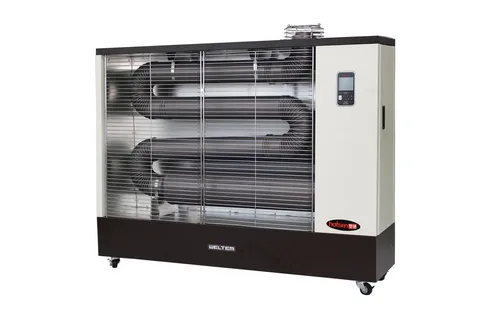How Far infrared Heater Work: A Comprehensive Guide

When winter’s chill settles in, finding an efficient and effective way to keep your space warm becomes a top priority. Enter far infrared heater, the unsung hero of modern heating solutions! Imagine basking in a soothing warmth that feels like sunlight on your skin while enjoying lower energy bills and a cozy atmosphere. But how do these innovative devices work their magic? In this comprehensive guide, we’ll explore the science behind far-infrared heating—exploring its benefits, mechanics, and why it might be the perfect solution for your home or office.
Understanding Infrared Heating: What is Far-infrared?
Far-infrared (FIR) is electromagnetic radiation that falls within the infrared spectrum. It has longer wavelengths than visible light, making it invisible to the human eye. However, despite its invisibility, FIR has been proven to have numerous benefits when it comes to heating.
The first thing to understand about far-infrared heating is that it works by emitting heat in the form of electromagnetic waves. These waves travel through space until they come into contact with an object or surface, where they are absorbed and transformed into heat energy. This process is known as thermal radiation.
Unlike traditional convection heaters, which rely on hot air circulating in a room to provide warmth, FIR heats objects directly without heating the air. This means that with FIR heaters, you can feel the warmth almost instantly after turning them on.
One of the key characteristics of far-infrared radiation is its ability to penetrate deeply into objects and tissues. This makes it particularly effective for providing targeted and even heat distribution. FIR can also stimulate blood circulation and promote cell regeneration, making it beneficial for health purposes.
But how does this all work in a practical sense? Let's consider how far-infrared heaters work in a home setting. Imagine you have an FIR panel heater mounted on your wall. As soon as you switch it on, it emits far-infrared waves at a specific wavelength designed to be most efficient for heating.
How Far-infrared Heaters Work: The Science Behind It
Far-infrared heaters operate on a unique principle of thermal radiation. Unlike conventional heating methods that warm the air, these heaters emit infrared waves directly absorbed by objects and people nearby.
When far-infrared rays hit surfaces, they transfer heat through molecular vibration. This process creates warmth without raising ambient air temperature significantly. The technology behind far-infrared heating often involves ceramic or carbon elements. These materials are efficient at converting electrical energy into radiant heat.
Moreover, this form of heating reaches deeper layers of skin and tissues, promoting blood circulation and muscle relaxation. Many users find it more comfortable since it mimics natural sunlight without harmful UV exposure. As energy-efficient solutions gain popularity, understanding how these heaters function is essential for making informed decisions about home comfort systems.
Benefits of Far-infrared Heating
One of the standout benefits of far-infrared heating is its ability to provide consistent warmth. Unlike traditional heaters that warm the air, infrared heaters penetrate deep into objects and surfaces, creating a cozy environment.
This type of heating can also be more energy-efficient. It directly heats people and objects instead of wasting energy on warming empty spaces. As a result, you may notice lower energy bills during colder months.
Health enthusiasts often praise far-infrared heating for potential wellness benefits. Some studies suggest it can improve circulation and relieve muscle tension. The gentle heat promotes relaxation without drying out the air. Another advantage is its versatility. Far-infrared heaters are available in various sizes and designs, suitable for any room—from living areas to bathrooms—ensuring comfort wherever you need it most.
Types of Far-infrared Heaters
Far-infrared heaters come in various models, each tailored to specific needs. Some common types include sleek panel heaters, which can be mounted on walls or ceilings. They blend seamlessly into any space while providing efficient heating.
Another popular option is portable infrared heaters. These units are easy to move around, making them ideal for targeting different areas of your home or office as needed. They often come with wheels for added convenience. You might also encounter infrared quartz tube heaters that offer rapid warmth through glowing elements. These are perfect for quick heat during cold snaps.
Lastly, far-infrared saunas are explicitly designed for health benefits and relaxation. These specialized units use the same technology but promote a unique wellness experience. Each type serves distinct purposes while delivering the soothing warmth only far-infrared can provide.
Choosing the Right Far-infrared Heater for Your Space
Choosing the right far-infrared heater for your space ensures maximum efficiency and effectiveness. With a wide range of options available in the market, it can be overwhelming to determine which one best fits your specific needs. This section will discuss some key factors to consider when selecting a far-infrared heater for your space.
1. Size and Coverage Area
The first step in choosing an infrared heater is determining the size and coverage area of the space you want to heat. Far-infrared heaters come in various sizes and heating capacities, so choosing one that can effectively cover the square footage of your room is essential. A larger heater may consume more energy than necessary for a smaller space, while an undersized heater may not provide enough heat.
2. Power Output
The power output or wattage of an infrared heater determines its heating capacity. Higher wattage means more heat output, but it also translates to higher energy consumption. Based on your specific heating needs, it's essential to strike a balance between power output and energy efficiency.
3. Type of Heater
Far-infrared heaters come in different types, such as portable, wall-mounted, or freestanding units. Portable heaters are easy to move around and ideal for smaller spaces or spot heating, while wall-mounted or freestanding ones are better suited for larger areas.
4. Heating Technology
Two main types of far-infrared heating technologies Ceramic and carbon fibre panels are two are ceramic and carbon fibre panels. Ceramic heat cools down just as fast once turned off, making them more suitable for short-term use. On the other hand, carbon fibre panels emit consistent heat over time and retain warmth even after being switched off.
Choosing the right far-infrared heater involves considering size, power output, type, heating technology, safety features, and energy efficiency. By keeping these aspects in mind while shopping for a far-infrared heater, you can find the perfect one to meet your heating needs effectively and efficiently.
Installation and Maintenance of Far-infrared Heaters
Installing a far-infrared heater is straightforward. Most models come with user-friendly instructions, making them accessible for DIY enthusiasts. Ensure you choose an appropriate location that maximizes heat distribution while keeping safety in mind.
Before installation, check your electrical capacity to support the heater's wattage. Proper mounting and secure connections are vital to prevent any hazards. Maintenance is minimal compared to traditional heating systems. Regularly dusting the unit helps maintain efficiency. If your heater has filters, clean or replace them as the manufacturer recommends.
Occasionally inspect wiring and components for wear or damage if used frequently. This will ensure longevity and optimal performance throughout its lifespan. With proper care, a far-infrared heater can serve you well season after season.
Eco-Friendly and Energy Efficient: Why Choose a Far-infrared Heater?
Far-infrared heaters stand out for their remarkable energy efficiency. Unlike traditional heating systems that warm the air, these heaters directly heat objects and people in a space, meaning less energy is wasted heating empty rooms. Using far-infrared technology can result in lower utility bills. Many users report significant savings after switching from conventional heating methods.
Moreover, they operate quietly, creating a comfortable environment without the noise often associated with forced air systems. The gentle warmth promotes relaxation and well-being. Another key aspect is their eco-friendliness. Far-infrared heaters produce minimal emissions compared to gas—or oil-based options and use fewer resources during manufacturing.
This type of heater supports sustainable living while ensuring comfort throughout colder months. It's an investment not just in warmth but also in reducing your carbon footprint over time.
Conclusion
When considering a heating solution, far infrared heaters present an appealing option for many households and workplaces. Their ability to heat objects and people directly rather than warming the air can increase comfort levels. If you're looking for energy efficiency, these heaters often consume less electricity than traditional systems. Assessing your space's needs is crucial. Far-infrared heaters come in various styles and sizes, making finding one that fits seamlessly into your environment easier. They are straightforward to install and maintain, which adds convenience.
FAQs
Q: Are far-infrared (IR) heaters safe to use?
A: Yes, far-infrared heaters are considered safe to use. They emit low levels of electromagnetic radiation and do not produce harmful UV rays, making them a safer option than traditional heating methods.
Q: How much electricity do far-infrared heaters consume?
A: The amount of electricity an IR heater consumes depends on its wattage and duration. On average, a 1000-watt IR heater can cost around $0.15 per hour to operate.
Q: Can I install a far infrared heater in my bathroom?
A: You can install a far infrared heater in your bathroom if it is properly vented and follows electrical safety regulations. However, it is recommended to consult with a professional electrician before installation.
|
Related Business Listings |






